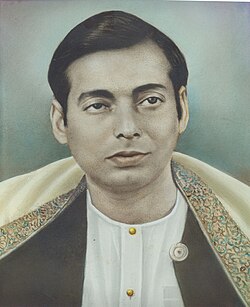Tarapada Chakraborty
This article needs additional citations for verification. (January 2014) |
Tarapada Chakraborty | |
|---|---|
 | |
| Background information | |
| Birth name | Tarapada Chakraborty |
| Born | April 13, 1909 Kotalipara, Bengal Presidency, British India (now in Bangladesh) |
| Died | September 1, 1975 (aged 66) Kolkata, West Bengal , India |
| Genres | Indian classical music |
| Occupation(s) | Singer |
| Years active | 1925–1975 |
| Website | tarapadachakraborty |
Tarapada Chakraborty[1] (April 13, 1909 – September 1, 1975) was an Indian classical vocalist. He was born in Kotalipara, Faridpur, Bengal Presidency (now in Bangladesh) to a Vedic Brahmin family. He is known for the khyal and thumri forms of singing, as well as for his popular renditions of Raagpradhans. He is the pioneer of the Kotali Gharana which is best known for its slow rendition of alap while presenting a raga.[2] He was the first Indian classical artiste to have presented any Raaga in 48-beats vilambit format, which is considered to be a difficult rendition in itself. He is the creator of Raaga Chhaya Hindol and Navamalaka.[3]
In 1972, he was awarded the Sangeet Natak Akademi Fellowship the highest honour conferred by Sangeet Natak Akademi, India's National Academy for Music, Dance and Drama.[4] He was the recipient of State Academy Award from Rabindra Bharati University in 1972.
References[edit]
- ↑ "The master with a nose for music". The Telegraph, Sunday , March 29, 2009.
- ↑ "Kotali Gharana - origin and history". biswabratachakrabarti.com. Retrieved 2021-07-20.
{{cite web}}: CS1 maint: url-status (link) - ↑ "Profile". sangeetnatak.gov.in.
{{cite web}}: CS1 maint: url-status (link) - ↑ "SNA: List of Sangeet Natak Akademi Ratna Puraskarwinners (Akademi Fellows)". Official website. Archived from the original on 2014-12-06.
